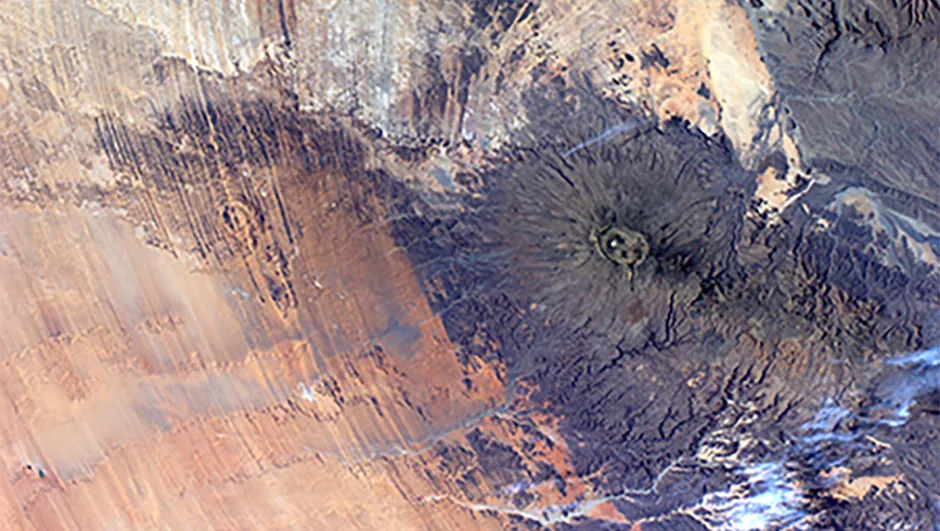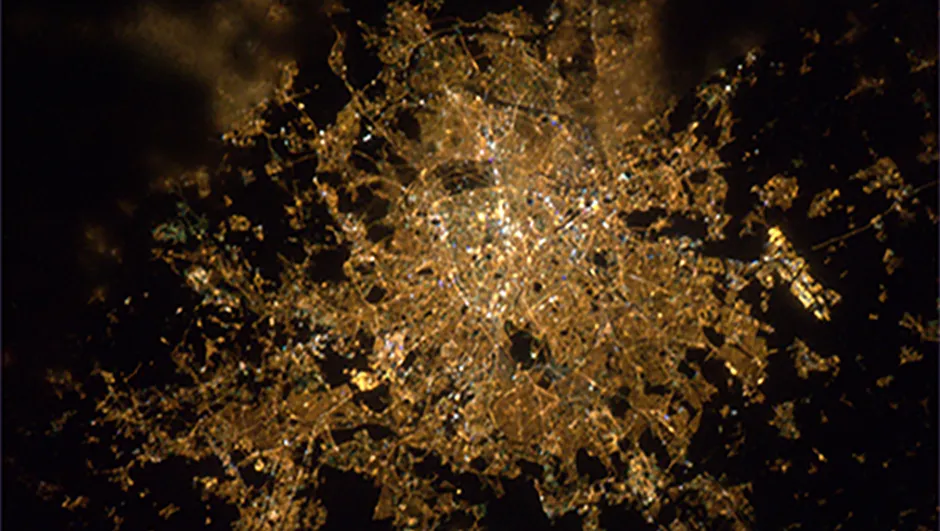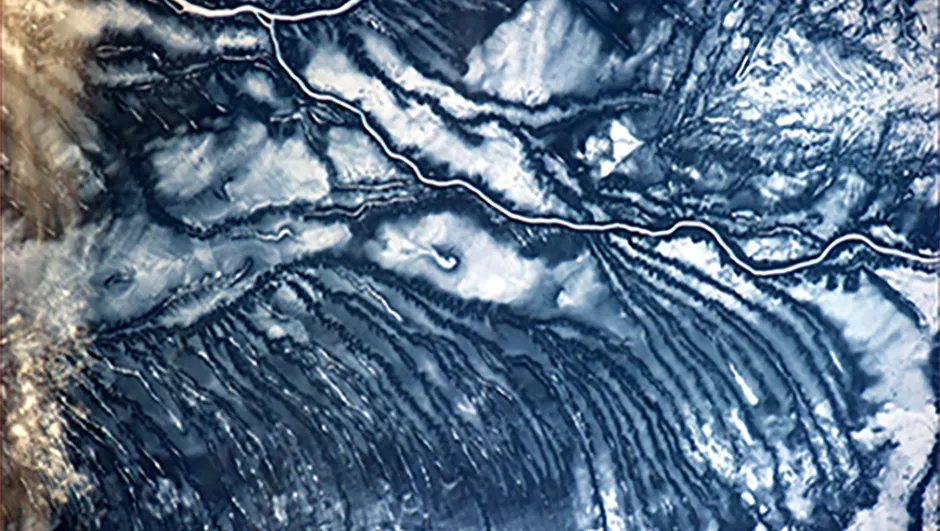Paolo Nespoli celebrates Italy's 150th anniversary while on board the International Space Station. Image Credit: ESA/NASA
The photos taken by astronauts on the International Space Station and sent back to Earth are a key part of the public’s connection with life on board the floating laboratory.
Images of rivers, cities by night, icy landmasses and red sandy desserts provide a new perspective on the beauty and diversity of our home planet.
We spoke to Italian ESA astronaut Paolo Nespoli, who worked on the ISS from December 2010 to May 2011 as part of his MagISStra mission, to find out what it is about floating in Earth’s orbit that makes astronauts want to capture what they see.

Paolo Nespoli: I think it’s different for each astronaut, so I can only really speak for myself, but I have loved photography ever since I was a kid.
When I was about 12 or 13 I joined a local photography club, built my own dark room, developed my own pictures and my camera was with me wherever I went.
I was always documenting the things around me.
I kept this up when I went into the army and then also when I went to NASA to train to be an astronaut.
Being in space and seeing the Universe from a different perspective really makes you want to document and take pictures.
It’s so beautiful; you just can’t help yourself and it is something that all astronauts like to do. It’s easy to understand why.
If you were out and about in London and had an hour to spare, you might take a picture of your surroundings, say Nelson’s Column or some of the lions in Trafalgar Square.
If you’re in space and you have an hour to spare, you can go to the cupola, which is this beautiful window to the world we have on board the ISS.
You are travelling at eight kilometres per second in orbit, which means in an hour and a half you will have spun round the whole world.
So if you look down on Earth and see everything is white with snow all around, all you have to do is wait a few minutes and it will be spring.
Wait a few more minutes and it will be summer.
In space you have such a unique view that allows you to see things you usually cannot.
Imagine if you were in Paris and you went to the Louvre to look at the Mona Lisa.
If you have your face pressed up against the painting, you won’t be able to appreciate the full impact.
In space, when you are 400km above Earth, you can’t see the finer details like individual trees or people, but you can see things that no one else can: rivers from where they begin to where they end up in the sea, coastlines, cities, mountains.
You really get a different perspective and it becomes natural to want to snap a picture, share it with other people and tell them what you discovered.
I remember taking a picture of a thunderstorm, for example, and trying to catch lightning from space, which I actually achieved!
These pictures end up looking quite surreal and if you don’t know what they are, it’s difficult to make sense of them.
So the vantage point of the ISS really gives you an interesting perspective.

Is there a scientific benefit to astronauts’ photos from space?
PN: Yes and no.
We already have satellites in space that can take very detailed pictures and even have the capability of taking different spectral images to analyse things like, for example, crop production or other human processes.
These satellites are active all the time and can repeatedly take the same pictures of glaciers or rivers or things like that.
So these are really the main source of Earth observation from a scientific point of view.
The photos we take in space by hand are mostly artistic; however in some cases we are asked to take specific pictures.
For example, we are able to take side-on pictures from the space station, which is something satellites can’t really do.
With these slanted pictures, we can do things like document the depth of pollution.
I remember taking pictures of a city from a side-on position, and you could actually see and measure the depth of the pollution that was covering it.
This is something that you can’t really see if you take a picture head-on from a satellite.
Also, you can pick up certain details by eye that might not be so obvious from a satellite.
Then, of course, once you know what you are looking at, the satellite can focus in on the object better than you can with your handheld camera.
There was a case that happened with a crew before me, who noticed a volcano erupting on Earth.
Nobody on Earth knew this was happening, but the astronauts were able to pick it up from space.
It wasn’t dangerous because there were no people living around it, but the ashes could have disrupted airline travel so it was good that the crew discovered it first.
I also experienced something similar myself with some photos I took of islands in the Pacific.
A few months later I found a scientific paper online that used my pictures to determine that an island I had photographed was in fact an erupting volcano that nobody knew about!
Earth observation is still best done by satellite, and we achieve scientific results with our own photos more by serendipity, but I think it puts a personal touch on the images when they are taken by a human being.
Pictures of Earth from above have been around for years and nobody really looked at them.
But now, while our pictures may not be scientific, the human touch perhaps makes people pay more attention.
Observing the Earth from this distance also helps us remember that the things we do have an effect; things that happen in the UK can change the climate in France, for example, which is something that you don’t really think about.
Through the eyes of an astronaut, these issues become more apparent to the general public, and I think this does have some sort of influence on the world.

Has it changed your own perception of the world?
PN: Well there is obviously the overall view of Earth that you get from space, which makes you aware of certain things that you cannot perceive from the ground.
Earth looks beautiful from space, but it also looks very fragile; it looks like a sphere balanced on top of a pin that could easily be blown away.
It gives you a feeling that the world is extremely delicate.
On one occasion I was trying to get a picture of the European Astronaut Centre in Cologne, Germany, and was taking pictures of the area.
But when I checked, it turned out I was also capturing Belgium, Holland; all around the neighbouring countries.
On Earth we tend to think of our town, our region, our country and that’s it.
We think that everything we do stays in our area, but from space it’s really obvious that everyone has the ability to influence everybody else.
It becomes obvious how much we are changing this planet.
We make small changes, like cities being built in the ocean in the Emirates, say.
From space you can see that these structures are really changing the course of the currents around them.
We take rivers and want to make them flow in a certain way so we build dams.
But from space you can see that we are really constraining nature.
A river from space almost looks alive; something that could change its course at any point.
And they do.
From space you can see where the river has been over the last thousand years.
We try and constrain the width of rivers and build cities around them, then we are amazed when we get flooding.
From space, it is obvious that this would happen!
You get a better perception of how nature works and how we try to force it to behave the way we want, instead of trying to accommodate so we can live side by side.
I always tell people that, paradoxically, it takes a human being to fly in space and become an extra-terrestrial in order to become a better terrestrial being.
I wish everybody could observe the beauty of the planet from space and realise that we need to pay attention to what is happening globally, which we usually don’t.

Would you encourage future astronauts to bring a camera with them and take photos from the station?
PN: On the space station we have plenty of cameras for us to document all the research we are doing and record data to be sent to the ground, so there isn’t actually any need to bring one with you!
In fact, the cameras get degraded very quickly because they get bombarded by radiation from space, so they only keep for about a year or so.
There is a continuous supply of new cameras and lenses arriving all the time.
But I am sure that, if you are in space and you look down, the desire to take a picture is unavoidable.
You are going to grab a camera and immediately capture what you are seeing, both for you to preserve the memory, and also for others to see back on Earth.
So I wouldn’t even need to tell future astronauts to take photos: it’s inevitable…